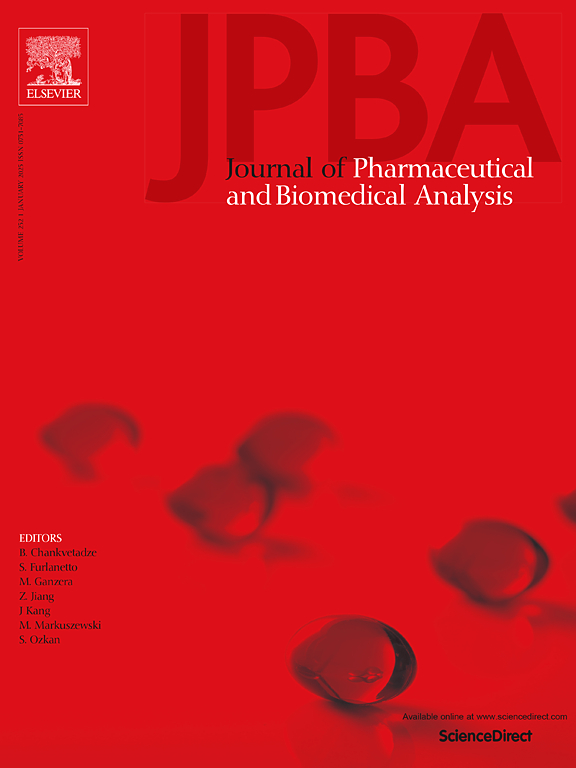Unveiling the effect of chemical degradation on cyclic lipoglycopeptide Oritavancin using Orbitrap mass spectrometry
IF 3.1
3区 医学
Q2 CHEMISTRY, ANALYTICAL
Journal of pharmaceutical and biomedical analysis
Pub Date : 2025-03-03
DOI:10.1016/j.jpba.2025.116745
引用次数: 0
Abstract
Oritavancin is the second-generation approved semisynthetic cyclic lipoglycopeptide by the United States Food and Drug Administration (USFDA) for acute bacterial skin and skin-structure infections which serves as a last resort of treatment. Unlike other lipoglycopeptides, the stability behavior of Oritavancin was least explored, which is a prerequisite. The current study endeavors to elucidate the oxidative, hydrolytic, thermal and photolytic stability behavior of Oritavancin by exposing the drug to respective stress conditions. A simple liquid chromatography (LC) method was developed, where significant resolution between Oritavancin and the generated degradation products was achieved. In total 13 degradation products were identified under various stress conditions. Using LC-HRMS, MS/MS studies, the generated degradation products were identified and characterized. The intact mass for DP-2,7,12 was m/z 724.7219(2), DP-6,11, 13 was m/z 796.2672(2), DP-3,10 was m/z 643.6953(2). However isomeric mass as of ORT intact form was seen for DP-4 and unique masses were identified for DP-1,4,8,10 with m/z 725.4293(2), m/z 905.2965(2), m/z 863.2896(2), m/z 904.2890(2) respectively. The mechanistic fragmentation pathway for all the generated DP's were established and the plausible structure for the identified DP's were postulated based on the MS/MS data. According to the findings, Oritavancin is highly susceptible to photolytic, thermal and hydrolytic condition and least susceptible under oxidative condition. The developed reversed-phase high-performance liquid chromatographic (RP-HPLC) method was validated in accordance with ICH guidelines for Oritavancin using C18 analytical reverse-phase column which could be utilised for routine quality control and therapeutic drug monitoring of Oritavancin.
求助全文
约1分钟内获得全文
求助全文
来源期刊
CiteScore
6.70
自引率
5.90%
发文量
588
审稿时长
37 days
期刊介绍:
This journal is an international medium directed towards the needs of academic, clinical, government and industrial analysis by publishing original research reports and critical reviews on pharmaceutical and biomedical analysis. It covers the interdisciplinary aspects of analysis in the pharmaceutical, biomedical and clinical sciences, including developments in analytical methodology, instrumentation, computation and interpretation. Submissions on novel applications focusing on drug purity and stability studies, pharmacokinetics, therapeutic monitoring, metabolic profiling; drug-related aspects of analytical biochemistry and forensic toxicology; quality assurance in the pharmaceutical industry are also welcome.
Studies from areas of well established and poorly selective methods, such as UV-VIS spectrophotometry (including derivative and multi-wavelength measurements), basic electroanalytical (potentiometric, polarographic and voltammetric) methods, fluorimetry, flow-injection analysis, etc. are accepted for publication in exceptional cases only, if a unique and substantial advantage over presently known systems is demonstrated. The same applies to the assay of simple drug formulations by any kind of methods and the determination of drugs in biological samples based merely on spiked samples. Drug purity/stability studies should contain information on the structure elucidation of the impurities/degradants.

 求助内容:
求助内容: 应助结果提醒方式:
应助结果提醒方式:


